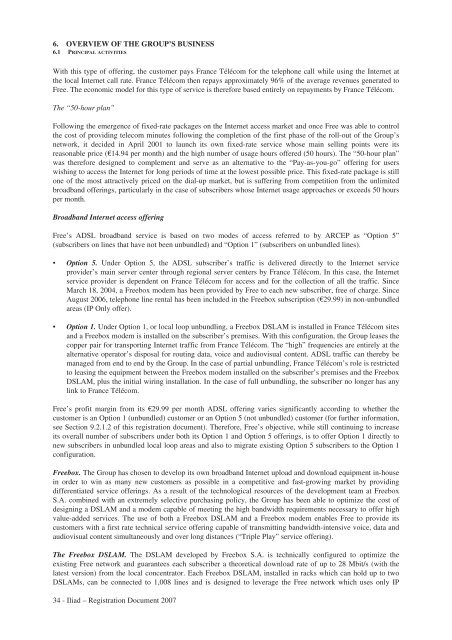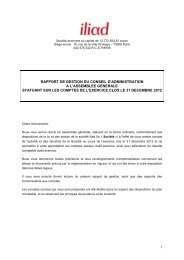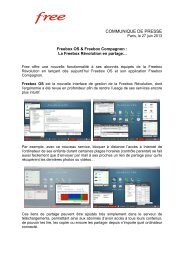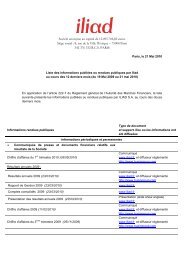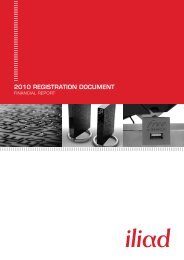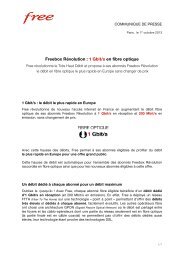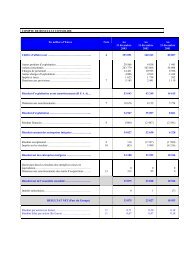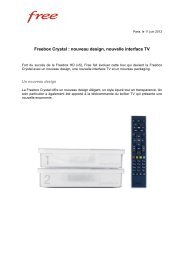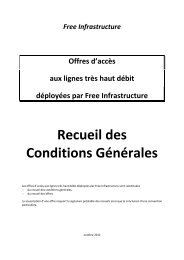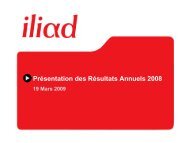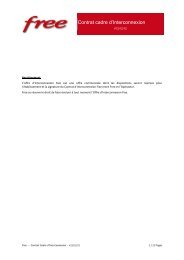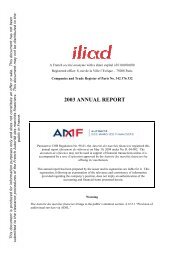REGISTRATION DOCUMENT AND FINANCIAL REPORT - Iliad
REGISTRATION DOCUMENT AND FINANCIAL REPORT - Iliad
REGISTRATION DOCUMENT AND FINANCIAL REPORT - Iliad
- TAGS
- registration
- iliad
- iliad.fr
You also want an ePaper? Increase the reach of your titles
YUMPU automatically turns print PDFs into web optimized ePapers that Google loves.
6. OVERVIEW OF THE GROUP’S BUSINESS<br />
6.1 PRINCIPAL ACTIVITIES<br />
With this type of offering, the customer pays France Télécom for the telephone call while using the Internet at<br />
the local Internet call rate. France Télécom then repays approximately 96% of the average revenues generated to<br />
Free. The economic model for this type of service is therefore based entirely on repayments by France Télécom.<br />
The “50-hour plan”<br />
Following the emergence of fixed-rate packages on the Internet access market and once Free was able to control<br />
the cost of providing telecom minutes following the completion of the first phase of the roll-out of the Group’s<br />
network, it decided in April 2001 to launch its own fixed-rate service whose main selling points were its<br />
reasonable price (€14.94 per month) and the high number of usage hours offered (50 hours). The “50-hour plan”<br />
was therefore designed to complement and serve as an alternative to the “Pay-as-you-go” offering for users<br />
wishing to access the Internet for long periods of time at the lowest possible price. This fixed-rate package is still<br />
one of the most attractively priced on the dial-up market, but is suffering from competition from the unlimited<br />
broadband offerings, particularly in the case of subscribers whose Internet usage approaches or exceeds 50 hours<br />
per month.<br />
Broadband Internet access offering<br />
Free’s ADSL broadband service is based on two modes of access referred to by ARCEP as “Option 5”<br />
(subscribers on lines that have not been unbundled) and “Option 1” (subscribers on unbundled lines).<br />
• Option 5. Under Option 5, the ADSL subscriber’s traffic is delivered directly to the Internet service<br />
provider’s main server center through regional server centers by France Télécom. In this case, the Internet<br />
service provider is dependent on France Télécom for access and for the collection of all the traffic. Since<br />
March 18, 2004, a Freebox modem has been provided by Free to each new subscriber, free of charge. Since<br />
August 2006, telephone line rental has been included in the Freebox subscription (€29.99) in non-unbundled<br />
areas (IP Only offer).<br />
• Option 1. Under Option 1, or local loop unbundling, a Freebox DSLAM is installed in France Télécom sites<br />
and a Freebox modem is installed on the subscriber’s premises. With this configuration, the Group leases the<br />
copper pair for transporting Internet traffic from France Télécom. The “high” frequencies are entirely at the<br />
alternative operator’s disposal for routing data, voice and audiovisual content. ADSL traffic can thereby be<br />
managed from end to end by the Group. In the case of partial unbundling, France Télécom’s role is restricted<br />
to leasing the equipment between the Freebox modem installed on the subscriber’s premises and the Freebox<br />
DSLAM, plus the initial wiring installation. In the case of full unbundling, the subscriber no longer has any<br />
link to France Télécom.<br />
Free’s profit margin from its €29.99 per month ADSL offering varies significantly according to whether the<br />
customer is an Option 1 (unbundled) customer or an Option 5 (not unbundled) customer (for further information,<br />
see Section 9.2.1.2 of this registration document). Therefore, Free’s objective, while still continuing to increase<br />
its overall number of subscribers under both its Option 1 and Option 5 offerings, is to offer Option 1 directly to<br />
new subscribers in unbundled local loop areas and also to migrate existing Option 5 subscribers to the Option 1<br />
configuration.<br />
Freebox. The Group has chosen to develop its own broadband Internet upload and download equipment in-house<br />
in order to win as many new customers as possible in a competitive and fast-growing market by providing<br />
differentiated service offerings. As a result of the technological resources of the development team at Freebox<br />
S.A. combined with an extremely selective purchasing policy, the Group has been able to optimize the cost of<br />
designing a DSLAM and a modem capable of meeting the high bandwidth requirements necessary to offer high<br />
value-added services. The use of both a Freebox DSLAM and a Freebox modem enables Free to provide its<br />
customers with a first rate technical service offering capable of transmitting bandwidth-intensive voice, data and<br />
audiovisual content simultaneously and over long distances (“Triple Play” service offering).<br />
The Freebox DSLAM. The DSLAM developed by Freebox S.A. is technically configured to optimize the<br />
existing Free network and guarantees each subscriber a theoretical download rate of up to 28 Mbit/s (with the<br />
latest version) from the local concentrator. Each Freebox DSLAM, installed in racks which can hold up to two<br />
DSLAMs, can be connected to 1,008 lines and is designed to leverage the Free network which uses only IP<br />
34 - <strong>Iliad</strong> – Registration Document 2007


